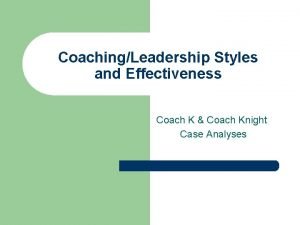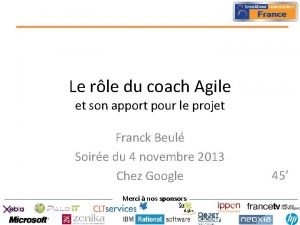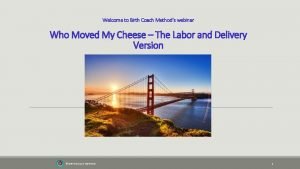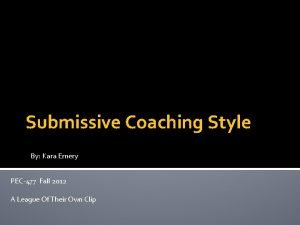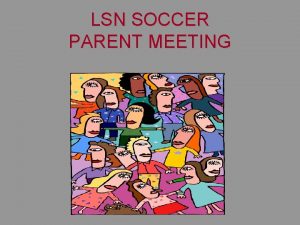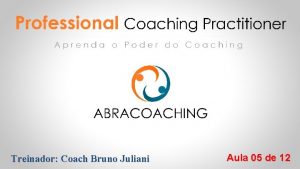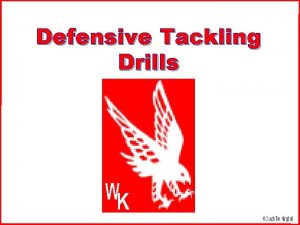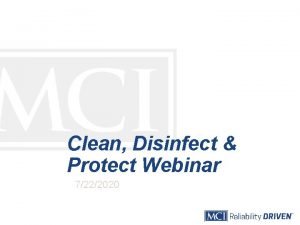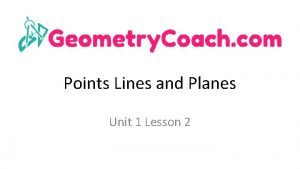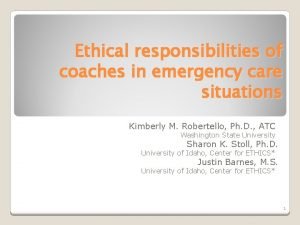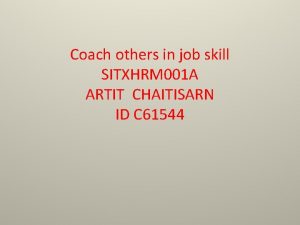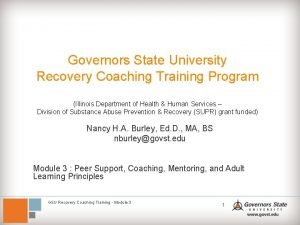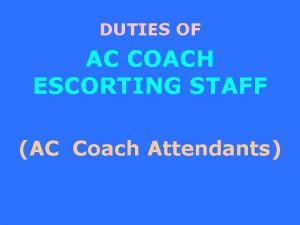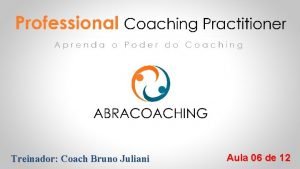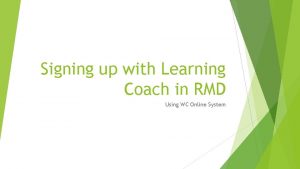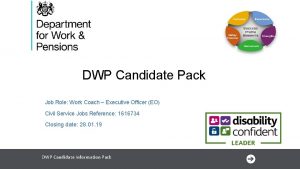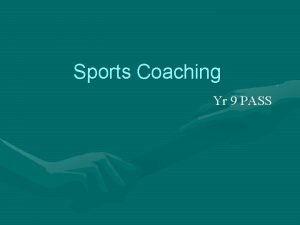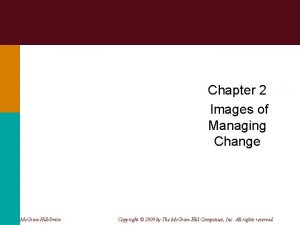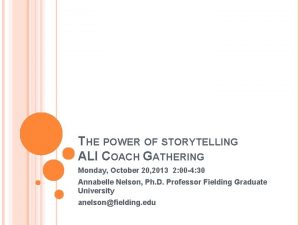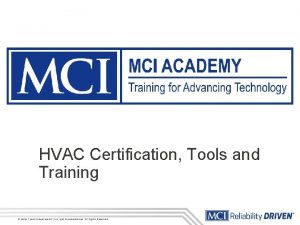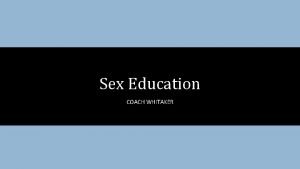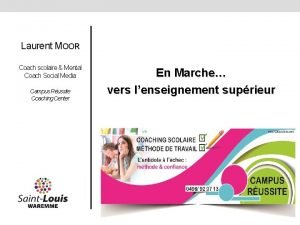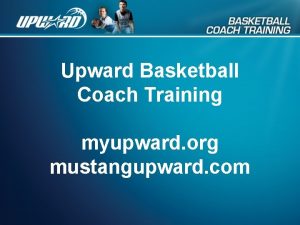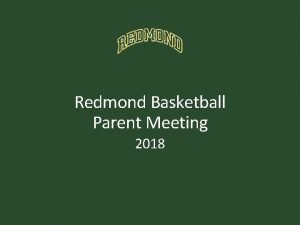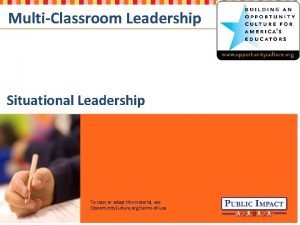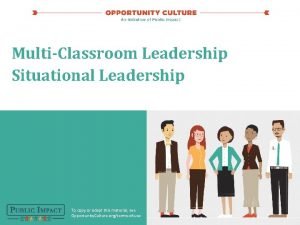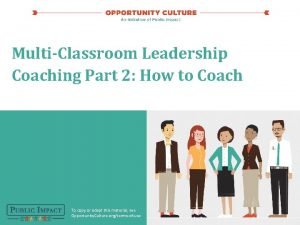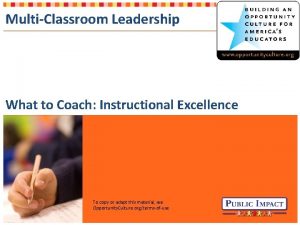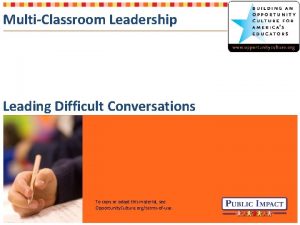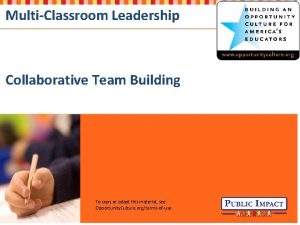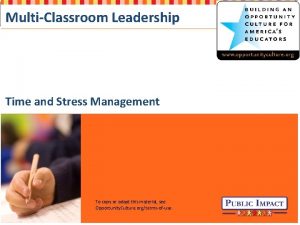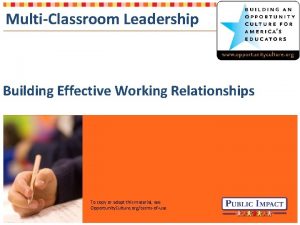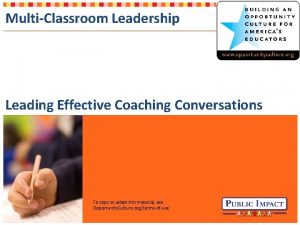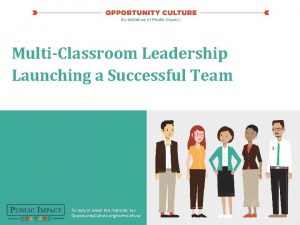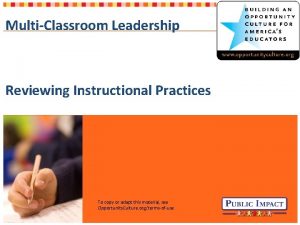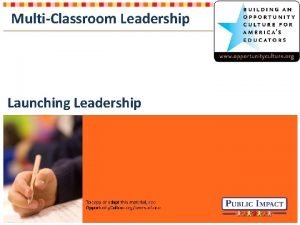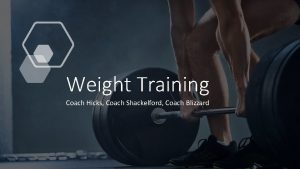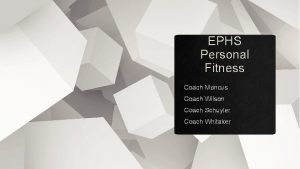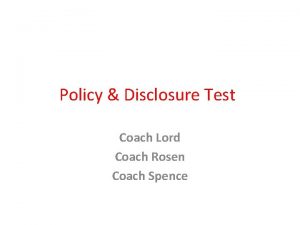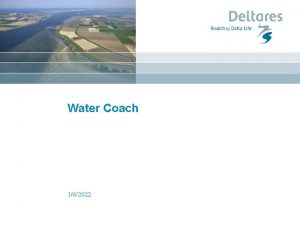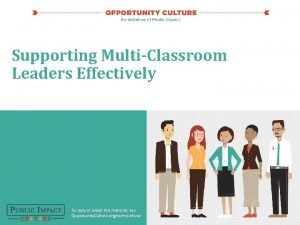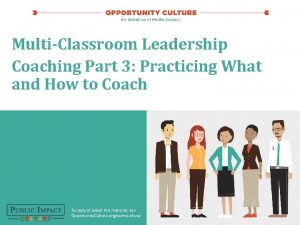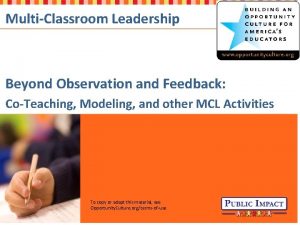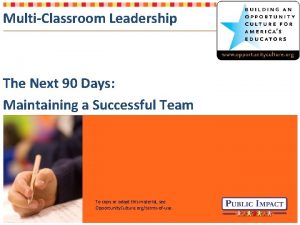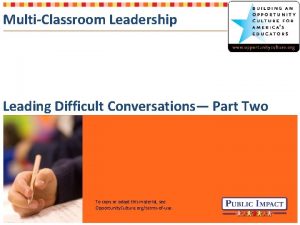MultiClassroom Leadership How To Coach To copy or





























- Slides: 29

Multi-Classroom Leadership How To Coach To copy or adapt this material, see Opportunity. Culture. org/terms-of-use

Do Now In your experience being coached or coaching others, how would you define coaching? © 2017 Public Impact Opportunity. Culture. org 2

Objectives During this session, participants will… • Define coaching and discuss the components of a coaching cycle. • Learn about tools used during informal observations and practice using tools in real time. • Learn about and practice using Leverage Leadership’s Six Steps for Delivering Effective Feedback to lead coaching conversations. • Explore ways to follow up coaching conversations with team teacher practice activities. © 2017 Public Impact Opportunity. Culture. org 3

Coaching: A Definition Coaching is partnering with individuals in a thought-provoking and creative process that inspires them to maximize their personal and professional potential. Coaches honor the client as the expert in his or her lift and work and believe every client is creative, resourceful, and whole. The coach’s responsibility is to: • Discover, clarify and align with what the client wants to achieve. • Encourage client self-discovery. • Elicit client-generated solutions and strategies. • Hold the client responsible and accountable. (International Coaching Federation, 2005) © 2017 Public Impact Opportunity. Culture. org 4

Feedback vs. Coaching What is the difference between feedback and coaching? What role can feedback play in coaching? Feedback Helps individuals be aware of strengths and areas of growth. Leads to acceptance that something needs to change. © 2017 Public Impact Coaching Helps individuals achieve the new goals that feedback helped them set. Opportunity. Culture. org 5

Build relationship, set vision, and norm on roles and expectations How to Coach: The Coaching Cycle Observe teaching, looking for implementation of action steps Facilitate debrief conversation to deliver feedback and identify action step(s) Provide interventions, as needed (i. e. model lesson, co-teach, etc. ) © 2017 Public Impact Opportunity. Culture. org 6

Formal Observation • High-stakes • • Evaluative • • Implications for contract renewal • Informal MCL Observation? ? • Low-stakes • Supportive • Non-evaluative • Timely, relevant • Short observation © 2017 Public Impact Summative Conducted by principal or AP Longer observation Opportunity. Culture. org 7

Before an Observation Agree on expectations for observation experience Determine the purpose of the observation Determine observation tool © 2017 Public Impact Opportunity. Culture. org 8

Agreeing on Expectations Meet with your team teachers to: • Ask about previous experiences with observation. • Clarify overall purpose for MCL observations: SUPPORT! • Discuss your observation style and expectations: • How will you move around the room? • How will you engage with students? • How will you jump in if you see an opportunity for support or clarification? • Plan for how you will tell students about what’s happening when MCL visits. © 2017 Public Impact Opportunity. Culture. org 9

Before an Observation Agree on expectations for observation experience Determine the purpose of the observation Determine observation tool © 2017 Public Impact Opportunity. Culture. org 10

Determine the Purpose Meet with individual team teacher for a preconference. • Approach this as a dialogue. • Discuss the lesson with success indicators and potential challenges. • Set one focus. • Agree on MCL behavior. © 2017 Public Impact Opportunity. Culture. org 11

Before an Observation Agree on expectations for observation experience Determine the purpose of the observation Determine observation tool © 2017 Public Impact Opportunity. Culture. org 12

Determine Observation Tool Does the tool: • Match the focus? • Align with goals for improving practice? • Have clear, standardized protocols? • Include guidelines for turning data into feedback? • Require a feasible amount of time? © 2017 Public Impact Opportunity. Culture. org T. Actions S. Actions 13

Generic, Quick Observation Tools T. Actions © 2017 Public Impact Opportunity. Culture. org S. Actions 14

Tool #1 Adapted from: Maywood University Clinical Supervision Handbook. Retrieved from http: //www. marywood. edu/dot. Asset/191876. pdf © 2017 Public Impact Opportunity. Culture. org 15

Tool #2 Adapted from Five Basic Types of Questions, by Leslie Wilson. Retrieved from http: //thesecondprinciple. com/teaching-essentials/fivebasic-types-questions/ Sample Observation Techniques Tool, retrieved from ttp: //assist. educ. msu. edu/ASSIST/school/mentor/workwith/toolobservation. pdf 16 © 2017 Public Impact Opportunity. Culture. org

Tool #3 Adapted from http: //assist. educ. msu. edu/ASSIST/school/mentor/workwith/toolobservation. pdf 17

Tool #4 Adapted from Danielson, Charlotte (2008). Electronic Forms and Rubrics for Enhancing Professional Practice: A Framework for Teaching, by Charlotte Danielson. Alexandria: ASCD. Retrieved from http: //www. peekskillcsd. org/cms/lib 07/NY 01913880/Centricity/Domain/31/Rubrics. Enhancing. Professional. Prac. doc © 2017 Public Impact Opportunity. Culture. org 18

During an Observation: Watching the Team Teacher Teach Make sure to: • Be on time • Bring the tool • Focus on the goal • Take evidence-based notes for specific feedback Not Evidence-Based: • Students are talking while teacher is giving directions. Evidence-Based Example: • 9: 20 a. m. – T: “All eyes on me and a voice level 0. ” 11/26 students immediately follow direction. • 9: 22 – 15/26 students silent. Teacher is giving directions; no redirection or consequences given to remaining off-task students. • 9: 27 – 17/26 students silently following along in notes. © 2017 Public Impact Opportunity. Culture. org 19

During Observation: Practice! © 2017 Public Impact Opportunity. Culture. org 20

After Observation Provide team teacher with a self-reflection form (optional). © 2017 Public Impact Organize your notes. • Determine what the data show. • Identify strengths, areas for improvement, and questions. Opportunity. Culture. org 21

Six Steps for Effective Feedback Step 1: Precise Praise Step 2: Probe Step 3: Concrete Action Step 4: Practice Step 5: Plan Ahead Step 6: Timeline Bambrick-Santoyo, Paul (2012). Leverage Leadership: A Practical Guide to Building Exceptional Schools. San Francisco: Joss -Bass. © 2017 Public Impact Opportunity. Culture. org 22

Criteria for Action Steps The probe that you ask your teacher should lead them to identify their own action step. Action steps should be: • Highest Leverage: Will this help the teacher to develop most quickly and effectively? Is it connected to a larger PD goal? • Clear and Measurable: Can anyone understand the action? Can you easily measure if the teacher has made the change? • Bite-Sized: If you can’t make the change in a week, the action step isn’t small enough. © 2017 Public Impact Opportunity. Culture. org 23

Coaching Demonstration © 2017 Public Impact Opportunity. Culture. org 24

Practice! 5 minutes: Prep your coaching conversation. Use the six steps handout and your notes from the observation. © 2017 Public Impact Opportunity. Culture. org 25

Practice! Time Allotted Activity 6 minutes Role-play the coaching conversation. • Partner 1 is MCL. Partner 2 is team teacher. 4 minutes Debrief the conversation: • What was strong about your partner’s facilitation of the coaching conversation? • What improvement would you suggest? • What are you taking away from this role play to implement in your own coaching practice? -- Switch roles -- © 2017 Public Impact Opportunity. Culture. org 26

Debrief Role-Play • What parts of the coaching conversation felt most natural? • What was strong about your partner’s facilitation of the coaching conversation? • What parts were difficult? • What do you feel you need more practice with? • What outstanding questions do you have about facilitating coaching conversations? © 2017 Public Impact Opportunity. Culture. org 27

Pop Quiz! • What is the difference between feedback and coaching? • Name the six steps of delivering effective feedback. • Extra credit: If you were working with a teacher with a fixed mindset, what adjustments would you make to your coaching approach? © 2017 Public Impact Opportunity. Culture. org 28

Sources • Bambrick-Santoyo, P. (2012). Leverage leadership: A practical guide to building exceptional schools. San Francisco, CA : Jossey-Bass. • Observing and Planning Effective Conferences with Beginning Teachers • Characteristics of Useful Feedback • How to Select the Right Classroom Observation Tool • Coaching Protocol for Post-Observation • Reflection Meeting Video • Danielson Framework Implementation Forms • Classroom Peer Observation © 2017 Public Impact Opportunity. Culture. org 29
 Coach k leadership style
Coach k leadership style What is adaptive leadership theory
What is adaptive leadership theory Adaptive leadership vs situational leadership
Adaptive leadership vs situational leadership Transformational leader and transactional leader
Transformational leader and transactional leader Qu est ce qu un coach agile
Qu est ce qu un coach agile Birth coach method
Birth coach method Submissive
Submissive Nlp master coach
Nlp master coach Lsn soccer
Lsn soccer Bruno juliani
Bruno juliani Oumar coach origine meme
Oumar coach origine meme Angle tackle defender tracks
Angle tackle defender tracks Motor coach industries
Motor coach industries Geometry coach points lines and planes
Geometry coach points lines and planes Legal and ethical responsibilities of a coach
Legal and ethical responsibilities of a coach Sitxhrm001 coach others in job skills
Sitxhrm001 coach others in job skills Recovery coach training illinois
Recovery coach training illinois Ac coach
Ac coach Bruno juliani coach
Bruno juliani coach Ephs moodle
Ephs moodle Dwp eo work coach
Dwp eo work coach Easy going coach
Easy going coach Images of managing change
Images of managing change Digital storyteller coach coaching
Digital storyteller coach coaching Kenny ray carter
Kenny ray carter Motor coach training
Motor coach training Sex education coach
Sex education coach Laurent moor
Laurent moor Upward basketball coaching resources
Upward basketball coaching resources Basketball coaches meeting agenda
Basketball coaches meeting agenda
